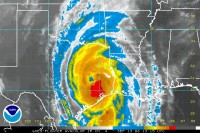By Joseph D’Aleo
Ike slammed ashore last evening a strong CAT 2 hurricane. It is moving rapidly north northwest and will rapidly get caught up in the westerlies. It hit an area heavily populated and rich in refineries and chemical plants. The storm was very large, larger in size than Katrina and Rita though those storms being more compact and stronger. Although the storm made landfall near Galveston, it had significant effects on Port Arthur and western Louisiana, also important to energy gathering and refining.

Ike brought memories of prior storms thst devastated this area over the past 108 years. Only time will tell how this storm will rank among those storms, but it will clearly be remembered. The worst storm of course as the great Galveston Hurricane of 1900. This article written in 2005 when Hurricance Rita threatened Galveston describes the great Galveston Hurricane of 1900, the nations worst natural disaster. They were the “most horrible sights that ever a civilized people looked up,” remarked Dr. Isaac M. Cline, a noted meteorologist based in the Texas city of Galveston. The date was Sept. 9, 1900, a day after the worst natural disaster in U.S. history.
Cline lost his pregnant wife among the 6,000-12,000 who perished after a hurricane roared ashore from the Gulf of Mexico, wiping out vast swaths of the city with huge storm surges and howling winds of at least 130 mph. The port city, then one of the wealthiest in America in terms of per-capita income, lay in ruins; it would take decades to rebuild Galveston again although it never recovered its former glory. The remodeled Galveston would include a 7-mile, 17-foot foot seawall to protect against future storm surges.
The storm wall was tested in Hurrcane Carla in 1961. Hurricane Carla was one of two Category 5 tropical cyclones during the 1961 Atlantic hurricane season. It struck the Texas coast as a Category 4 hurricane, becoming one of the most powerful storms to ever strike the United States and the strongest ever to hit Texas. The storm caused over $2 billion (2005 US dollars) in damages, but due to the evacuation of over 500,000 residents the death toll was only 43. Storm surge was measured at 22 feet (6.6 m) near the heads of bays, in some places penetrating 10 miles inland. Because of its large size, the entire Texas coast was affected, and damage was reported as far inland as Dallas. Sustained winds were reported to be 115 mph in Matagorda, 110 mph in Victoria and 88 mph in Galveston. Wind gusts as high as 170 mph were recorded at Port Lavaca. Pressure at landfall was measured at 931 mb (hPa), making it the eighth most intense hurricane to strike the United States in the 20th century. Then little-known newsman Dan Rather reported live from the Galveston Seawall during the storm, an act that would be imitated by later reporters. This marked the first live television broadcast of a hurricane.
Much of the damage was done well away from the landfall site, as Carla spawned one of the largest hurricane-related tornado outbreaks on record at the time, when 26 tornadoes touched down within its circulation. One F4 tornado ripped through downtown Galveston, killing several (sources differ on the exact number, varying from 6 to 12). Outside the protection of the Galveston Seawall, structures on the island were severely damaged by storm surge. Damage was reported as far east as the Mississippi River delta. Carla killed 43 people, 31 of them in Texas. The low death toll is credited to what was then the largest peacetime evacuation in US history.
Hurricane Alicia in 1983 struck Galveston and Houston, Texas directly, causing $2.6 billion USD$5.27 billion 2006 USD) in damage and killing 21 people; this made it the worst Texas hurricane since Hurricane Carla (1961 season) and Texas’ first billion-dollar storm. Hurricane Alicia was notable for the delayed evacuation of Galveston Island (since the eye of the storm traveled the evacuation route up I-45 from Galveston to Houston). The hurricane was also notable for the shattering of many windows in downtown Houston by loose gravel from the roofs of new skyscrapers and by other debris, prompting changes to rooftop construction codes. High gusts were reported throughout Texas, with a maximum gust of 125 mph reported on the Coast Guard cutter Buttonwood stationed at the northeastern tip of Galveston Island. Pleasure Pier reported tides of 8.67 feet, with Pier 21 reporting a little over 5.5 feet. Baytown, Texas reported 10-12 ft tides, and Morgan City reported 12.1 ft, the highest recorded as a result of Alicia. The storm also caused extensive disruption of power services. Twenty-three tornadoes were reported in association with Alicia. Fourteen of those were located in the Galveston and Hobby Airport area. (sources include NOAA, NWS HPB, NHC, USATODAY, Wikipedia).




